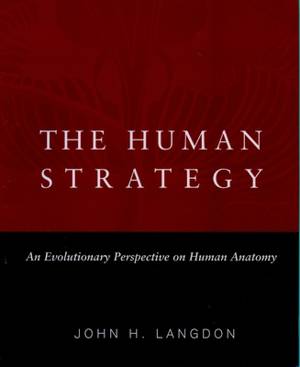
- Afhalen na 1 uur in een winkel met voorraad
- Gratis thuislevering in België vanaf € 30
- Ruim aanbod met 7 miljoen producten
- Afhalen na 1 uur in een winkel met voorraad
- Gratis thuislevering in België vanaf € 30
- Ruim aanbod met 7 miljoen producten
Zoeken
€ 83,95
+ 167 punten
Omschrijving
The Human Strategy brings a unique and accessible evolutionary approach to the study of human anatomy. Bridging the disciplines of anthropology and biology, it acknowledges that human beings are vertebrates, mammals, and primates, and that the anatomical systems of the human body reflect adaptations from each of these levels of classification. John H. Langdon identifies the significance of those traits that make humans distinct from other vertebrates, exploring adaptations to the musculoskeletal, nervous, and reproductive systems and to systems of homeostasis. He addresses the question: "What functions are represented in the body structure and what history lies behind them?" Framing the answers in terms of physiological goals, functional adaptation, and evolutionary contingency, he covers both soft- and hard-tissue systems. Langdon considers how behavioral changes in our ancestors--bipedalism and a changing diet that incorporated meat--relate to anatomical changes in nearly every organ system and contributed to expansion of the brain, a higher energy budget, and a prolongation of life history.
Integrating the most recent research in the field, The Human Strategy features more than 250 clear and well-labeled illustrations that explain anatomical systems and processes. It includes tables that detail the differences between the major classes of vertebrates, helping students to put evolutionary variations among species in context. A comprehensive glossary and an extensive bibliography are also provided. Ideal for upper-level undergraduate and graduate courses in human evolutionary anatomy, The Human Strategy can also be used in human anatomy and human evolution courses. Taking a more complete look at the human body in an evolutionary sense than any other existing text--and demonstrating that the human present is best understood in terms of our past--this volume serves as an excellent starting point for discussion, critical thinking, and further research.
Integrating the most recent research in the field, The Human Strategy features more than 250 clear and well-labeled illustrations that explain anatomical systems and processes. It includes tables that detail the differences between the major classes of vertebrates, helping students to put evolutionary variations among species in context. A comprehensive glossary and an extensive bibliography are also provided. Ideal for upper-level undergraduate and graduate courses in human evolutionary anatomy, The Human Strategy can also be used in human anatomy and human evolution courses. Taking a more complete look at the human body in an evolutionary sense than any other existing text--and demonstrating that the human present is best understood in terms of our past--this volume serves as an excellent starting point for discussion, critical thinking, and further research.
Specificaties
Betrokkenen
- Auteur(s):
- Uitgeverij:
Inhoud
- Aantal bladzijden:
- 384
- Taal:
- Engels
Eigenschappen
- Productcode (EAN):
- 9780195167351
- Verschijningsdatum:
- 10/02/2005
- Uitvoering:
- Hardcover
- Formaat:
- Genaaid
- Afmetingen:
- 193 mm x 244 mm
- Gewicht:
- 852 g

Alleen bij Standaard Boekhandel
+ 167 punten op je klantenkaart van Standaard Boekhandel
Beoordelingen
We publiceren alleen reviews die voldoen aan de voorwaarden voor reviews. Bekijk onze voorwaarden voor reviews.











